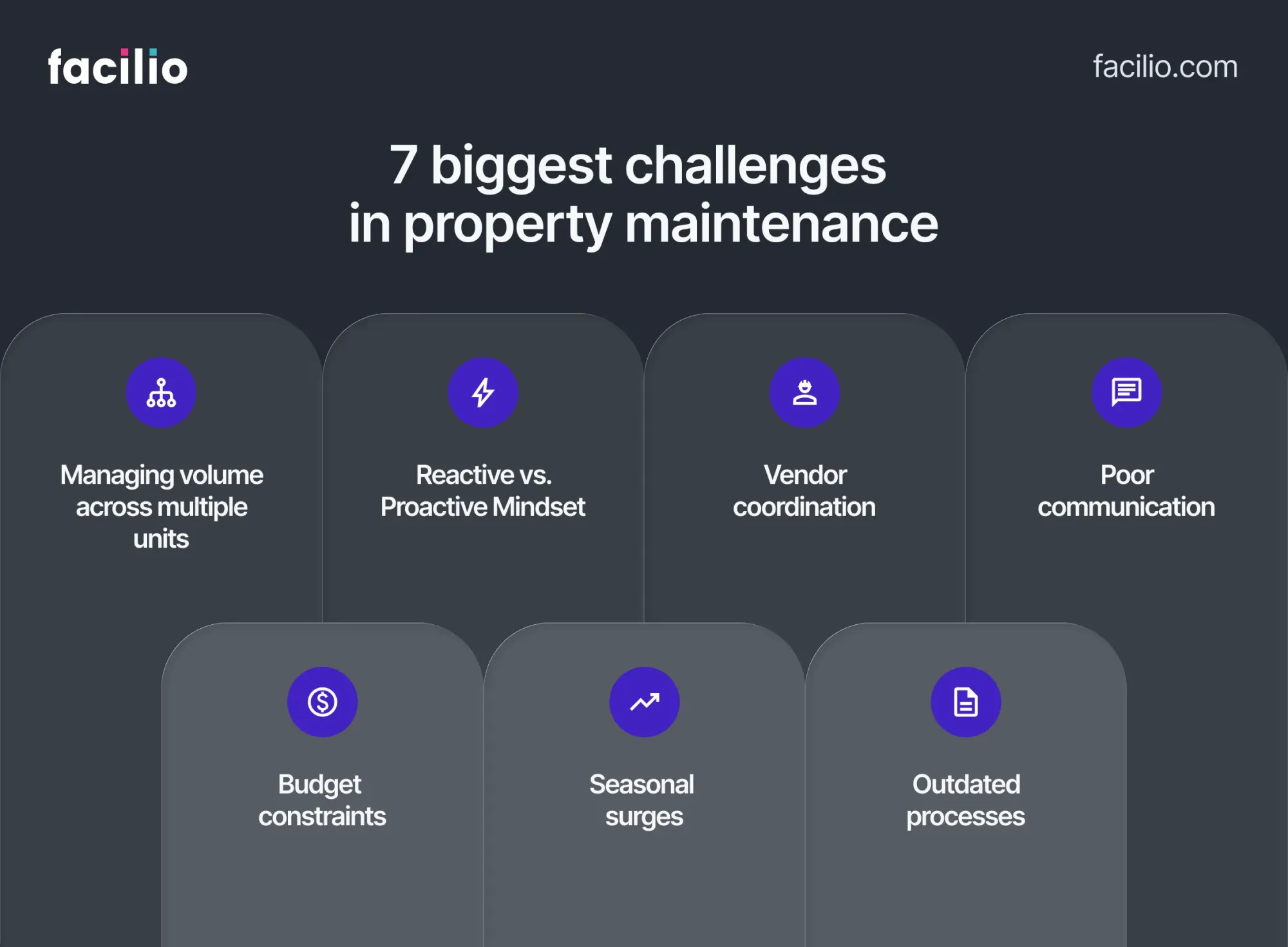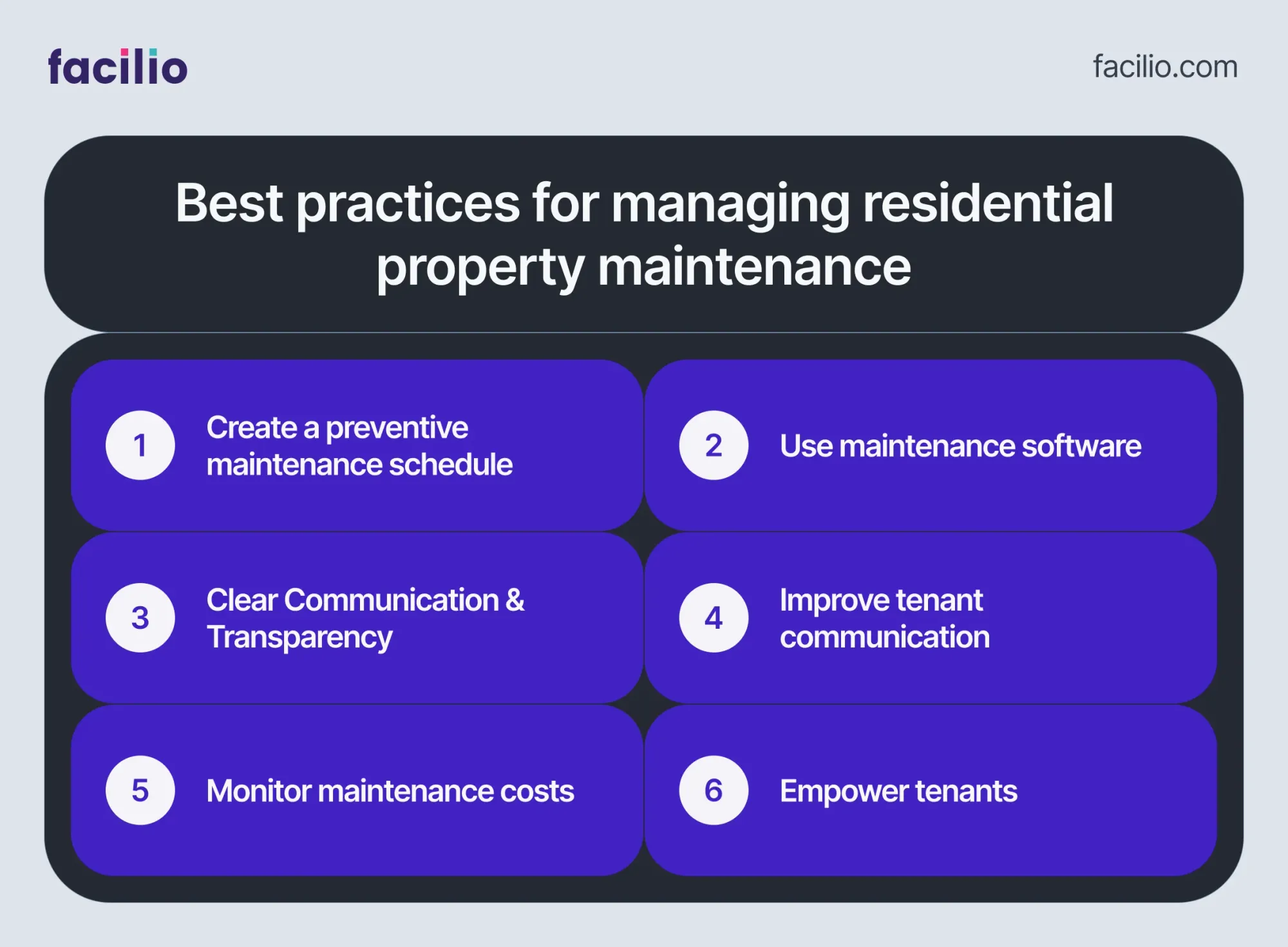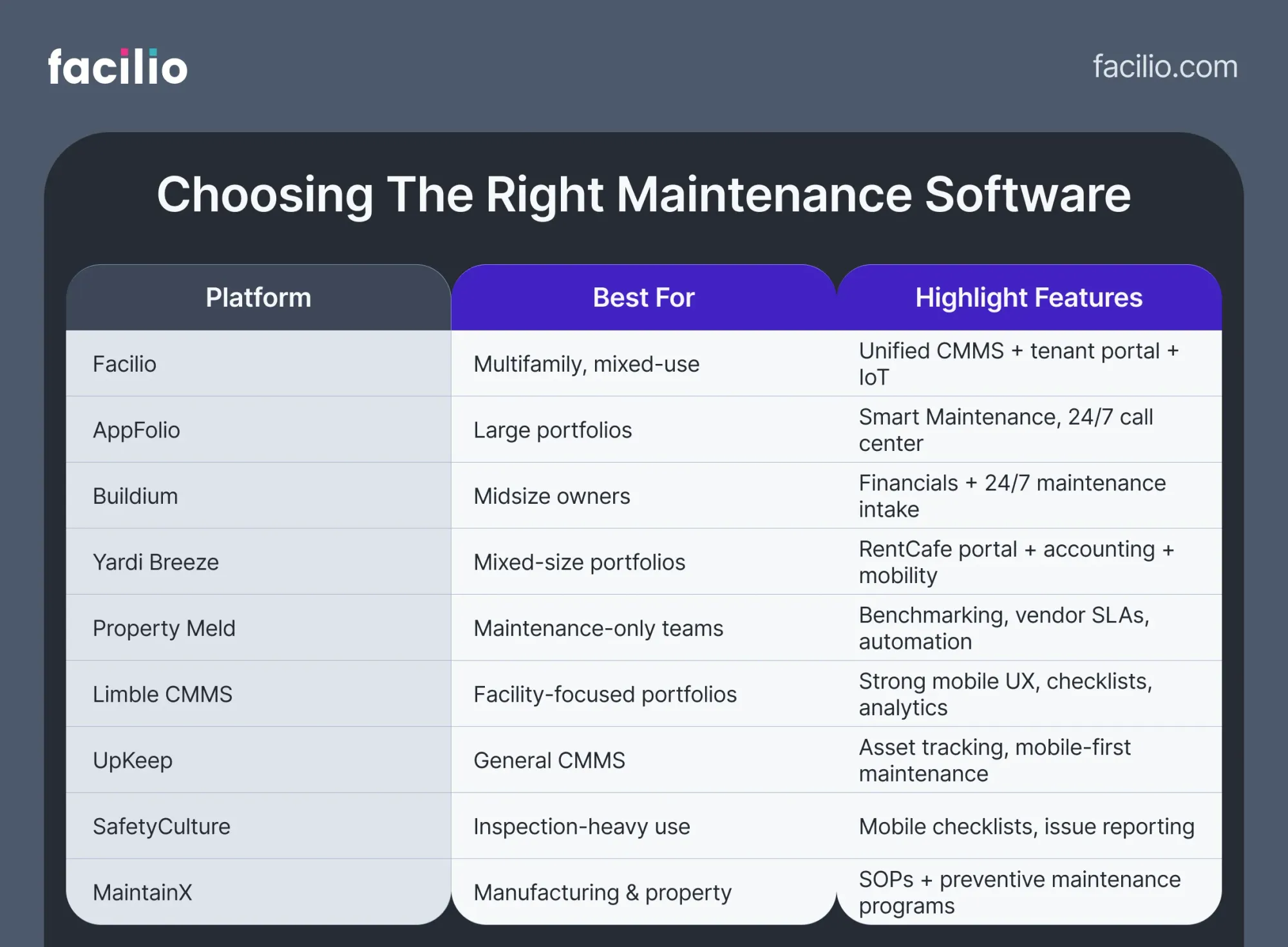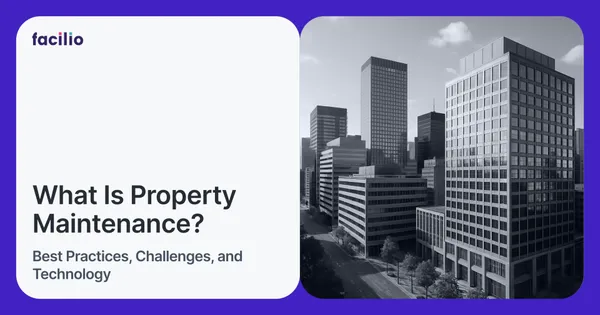Property maintenance refers to the ongoing upkeep, repair, and management of buildings and grounds to ensure they remain safe, functional, and attractive.
A well-executed maintenance program improves tenant satisfaction, increases lease renewals, and preserves property value. For property managers, maintenance supervisors, and service providers, proactive maintenance reduces emergency costs, supports compliance, and boosts reputation—making it a critical competitive advantage.
In this guide, we will explore what property maintenance entails, why it matters and best practices for managing it effectively.
Core elements of a property maintenance program
Preservation of a property to keep it in optimal condition encompasses a wide range of tasks required to ensure that a residential building or community remains safe, habitable, and appealing.
Typical aspects of property maintenance include:
- Building system checks and repairs: Regular inspections of electrical, plumbing, HVAC, elevators, and other systems to fix issues proactively and ensure everything is operational.
- Structural and cosmetic repairs: Fixing wear-and-tear in apartments and common areas from leaky faucets and broken doors to repainting walls and repairing roofing.
- Grounds and amenities upkeep: Maintaining landscaping, gardens, parking lots, pools, gyms, and other shared amenities across properties.
- Safety and compliance tasks: Testing fire alarms, sprinklers, and extinguishers; pest control; ensuring building codes and safety regulations are met to keep residents secure.
- Turnover maintenance: Deep cleaning and repairing of units during tenant move-outs and move-ins to prepare them for new residents.
For property managers handling large property portfolios, maintenance is a core responsibility. They serve as the point of contact for tenant maintenance requests and coordinate maintenance staff or contractors to carry out the work.
Why property maintenance services matter more than ever?

1. Tenant expectations are rising
Renters today expect more than just a place to live; they expect service. In fact, 87% of tenant complaints stem from poor maintenance experiences, with issues like unresolved leaks, slow turnaround, and lack of communication leading the charge (Marks Out Of Tenancy).
And it’s not just about comfort; maintenance satisfaction is directly tied to lease renewals and referrals. According to industry research, even a 1-point boost in resident satisfaction can reduce move-outs by nearly 20% (ERES).
2. Deferred repairs cost more
Waiting until something breaks costs far more than staying ahead of it. Studies show that reactive repairs are 3–4x more expensive than preventive fixes (OxMaint).
Take HVAC systems—routine servicing can extend their lifespan by 20%, while emergency repairs or full replacements can blow through budgets unexpectedly ; that’s how deferred maintenance quietly turns into a budget trap.
In one real-world example, a property saved nearly 50% by switching from reactive HVAC compressor repairs to scheduled preventive care (MicroMain).
3. Online reviews shape leasing
Prospects don’t just tour your property; they Google it first. A track record of poor maintenance on review platforms can tank your leasing funnel.
One case study showed that improving tenant satisfaction from 2.5 to 4.5 stars led to a 50% drop in vacancies and a 60% reduction in work orders due to better communication and service standards (Altitude Development Partners).
4. Compliance is non-negotiable
From fire codes to elevator inspections, there’s no wiggle room. Falling behind isn’t just risky—it’s expensive. Insurers may hike premiums for deferred maintenance, and cities are cracking down harder.
In the UK alone, 19% of tenants in social housing express dissatisfaction with repairs due to compliance delays (CIH).
7 biggest challenges in property maintenance
Managing maintenance across a portfolio of units or multiple buildings comes with several challenges. Recognising these pain points is the first step toward addressing them:

1. Managing volume across multiple units
Across large property portfolios, even ‘minor’ issues can multiply quickly, simply due to scale. A portfolio with hundreds or thousands of units will generate a steady stream of maintenance tickets – from leaky faucets to broken AC units
For every 100-unit property portfolio, expect 300+ service requests monthly, with spikes during move-ins and seasonal transitions (Property Meld Report).
Without a centralised system, juggling these across technicians, vendors, and tenants becomes a bottleneck.
2. Reactive vs. Proactive Mindset
Traditionally, many property managers operate in a reactive mode – addressing issues only after something breaks or a tenant complains.
If you’re still waiting for things to break before acting, you're bleeding money. Reactive maintenance tends to cost up to 400% more per incident (OxMaint).
This firefighting approach can overwhelm maintenance teams and lead to higher costs, as urgent fixes and emergency repairs take precedence.
3. Vendor coordination
Property maintenance often involves multiple parties – onsite maintenance staff, external contractors (plumbers, electricians, HVAC technicians), property managers, and of course, the tenants.
Coordinating between internal teams and third-party contractors without SLA tracking or performance data means jobs fall through, delays stack up, and tenants lose faith.
Without a centralised system, scheduling conflicts or delays are common. There’s also the challenge of managing vendor relationships and ensuring reliable contractors are available when needed – having a go-to vendor for each common issue can expedite repairs.
4. Poor communication
Sticky notes, phone tag, or lost emails? Not scalable. And not professional.
Tenants might not know how or where to report an issue, or their request might get lost in a pile of paperwork or missed phone calls. Property managers may struggle to update tenants on the status of a repair, especially if tracking is done manually.
Likewise, maintenance technicians need accurate information about the problem and access instructions.
According to Property Meld, lack of communication is the #1 tenant complaint, more than slow repairs or cost. Every miscommunication drives churn and burns your reputation.
5. Budget constraints
Every property has to balance the ideal maintenance standards with real-world budget limits. Hiring a large enough maintenance team or investing in new tools might be constrained by financial considerations
Property managers face the challenge of controlling costs without compromising on service quality.
Industry best practice? Set aside 10–15% of gross rent revenue annually for maintenance. Without that buffer, emergency repairs become financial landmines.
6. Seasonal surges
Maintenance demands can be seasonal. For example, in colder climates, winter can bring frozen pipes or heating system failures, while summer might stress air conditioning systems and produce more wear on pools or cooling towers
A lack of seasonal planning can create service backlogs. Data shows first heatwaves in summer drive a 3–4x surge in HVAC tickets across large property portfolios (Property Meld Report).
7. Outdated processes
Today’s tenants – especially younger generations, have increasingly high expectations for convenience.
They expect the ability to submit maintenance requests digitally at any time and get speedy updates on the progress. Failing to provide a modern, user-friendly experience can make a property less attractive in a competitive rental market.
58% of Gen Z renters say they won’t lease from a property that lacks self-service maintenance portals or online updates(RealPage). If your property isn’t offering digital-first experiences, you’re already behind.
Despite these challenges, the good news is that the property management industry has been evolving with best practices and innovative solutions to overcome them.
What are those best practices, and how can using technology address many of these pain points?
Best practices for managing residential property maintenance

1. Create a preventive maintenance schedule
Don’t wait for things to break. Use seasonal checklists and automated task creation to stay ahead of failures.
Preventive maintenance has been shown to deliver an ROI of 545% in large property portfolios(OxMaint). Over time, a proactive strategy will reduce emergency repairs, extend the life of building equipment, and keep the property running smoothly.
2. Use maintenance software
In the digital age, using modern maintenance management software is arguably a must for efficiency. The right software acts as a central hub for all maintenance activities.
Track metrics like time-to-complete, average cost per request, and tenant satisfaction per work order. One benchmark recommends keeping average resolution time under 48 hours and average cost under $175 per order (Proprli).
3. Clear Communication & Transparency
Maintenance is as much a communication challenge as a technical one. Don’t just fix things—let tenants know what’s happening and when.
Automated updates ("parts on order," "scheduled for Tuesday") reduce anxiety and cut down on follow-up calls. Bonus? It also builds long-term loyalty.
4. Improve tenant communication
Large properties rely on an ecosystem of trusted contractors for specialised maintenance tasks (plumbers, electricians, elevator technicians, landscapers, etc.). Building a reliable vendor network and managing those relationships is a best practice for ensuring quality work
Keep a database of vendor contacts with details like specialties, rates, availability, and past performance. Many maintenance software suites let you maintain vendor profiles for easy reference.
It’s also wise to have backup vendors in case your primary choice is unavailable, especially for critical systems.
5. Monitor maintenance costs
Effective maintenance management isn’t only about physical work; it also has a financial dimension. Budgeting adequately for maintenance and tracking expenditures are essential practices
Follow guidelines or rules of thumb that fit your property’s needs – for instance, some landlords set aside 1% of property value or 10-15% of annual rent revenue for maintenance costs per year
Properties that audit these trends quarterly are 23% more likely to stay under budget for major repairs(MRI Software).
6. Empower tenants
Lastly, an often-overlooked best practice is actively involving tenants in the maintenance equation: what they can fix, what they shouldn’t touch, and how to report issues.
When tenants understand that management is responsive and that they have a role in upkeep, it creates a more cooperative atmosphere. Properties that do this see lower maintenance request volumes per unit and better first-time fix rates (Source).
By implementing these best practices – from preventive planning and open communication to leveraging software and educating tenants – property managers can significantly improve their maintenance outcomes
How Technology Modernises Property Maintenance Services
- Tenant self-service is no longer optional
With platforms like Facilio, tenants can raise requests, upload photos, and track status 24/7. This doesn’t just streamline service—it cuts admin work by 30–40% and improves SLA adherence.
- Tenant Mobile Apps
Field staff using mobile tools resolve requests 28% faster and are twice as likely to document tasks fully, reducing callbacks and accountability issues.
- IoT integrations stop issues before they spread
Smart leak detectors or HVAC sensors tied into a CMMS can trigger automated work orders before tenants even notice. This alone can prevent 90% of widespread water damage in connected buildings.
- 24/7 Emergency Support and AI Assistants
Platforms offer 24/7 intake and triage via AI bots or human call centres. This ensures that emergency calls don’t go unanswered, even at 2 AM
Choosing the right property maintenance software
Here’s a quick comparison of the top platforms:

Done right, property maintenance becomes a differentiator, which is why choosing the right property maintenance software is crucial. It improves retention, lowers costs, strengthens reviews, and builds operational resilience. And with modern tech, even small teams can run like enterprise operators.
For property managers and companies aiming to stand out, the advice is clear: treat property maintenance as a priority, not an afterthought.
Invest in training your maintenance team, develop solid preventive maintenance routines, and equip yourself with systems that enhance communication and efficiency.
FAQs about property maintenance
1. What does property maintenance include?
It includes repairs, inspections, landscaping, pest control, unit turnover, fire safety checks, and compliance tasks that keep a building functional and safe.
2. How is commercial property maintenance different from residential?
Commercial properties often involve HVAC zoning, access control, higher safety codes, and more complex systems, requiring a dedicated maintenance property team or vendor.
3. What is the average cost of maintenance of a property?
Many property owners allocate 1% of property value or 10–15% of rent income annually for maintenance. Costs vary based on age, size, and location.
4. How do property maintenance programs help with tenant retention?
They reduce complaints, improve satisfaction, and build trust. Fast, predictable service is one of the biggest drivers of lease renewals.
5. What’s the role of a property maintenance company?
A property maintenance company handles repairs, inspections, emergency response, and upkeep—either independently or on behalf of property managers.

